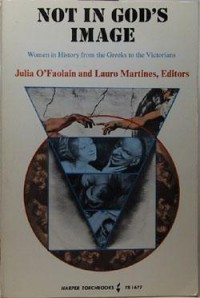Review


Julia O’Faolain was a novelist strongly concerned with the condition of women; in this volume, she compiled original historical sources in a work of research that would inform her later novels, most obviously the medieval drama Women in the Wall. It is by no means a systematic history, just a collection of excerpts, arranged roughly thematically. However, the claim in the introduction that "The book differs from others recently published in that its aim is not polemical" is an exaggeration, for many of the editorial contributions do indeed contain polemical comments. O’Faolain was not a professional historian, but her coauthor, her husband Lauro Martines, was (he specialized in the Italian Renaissance). Given that, I might have expected a little more theoretical sophistication and nuance than I found in the writing -- for instance, the sentence in the introduction, "The double standard had no other basis" than to insure "incontestably legitimate" heirs "and neither had the practice of keeping women in relative subjection and seclusion;" or the uncritical acceptance of the now-abandoned idea that there was a prehistoric period of matriarchy. Of course, we must keep in mind that this book appeared in 1973, and thus had as yet very little basis of feminist scholarship to draw on.
In the selections dating to antiquity and the middle ages, sources are pretty much limited to legal codes, rare court cases, and religious or medical pronouncements about the fundamental nature of woman. This leaves us lacking insight into the patterns of daily life, such as an anthropologist would like to have: for instance, we learn that the houses of ancient Athenians had separate secluded living quarters for women if they were large enough, and we have a mention of a two-storied house where husband and wife slept upstairs and the children and servants downstairs, but there is hardly enough material for an anthropological analysis of the ways that domestic space shaped life and thought. It is an unavoidable part of presenting extended texts, however, since the necessary evidence would be scattered and largely archaeological.
The variety of material available increases over time, and begins to expand enormously by about the 17th century. It is at this point that the book abandons any attempt to be generally representative, and instead becomes a scattering of interesting examples, with some chapters being more like case studies: for instance, the discussion of prostitution centers on an analysis of the 18th and 19th century police records in Paris, and the gradual expansion of women’s legal rights in England during the 19th century is seen through the lens of the life and writings of Caroline Norton. The arrangement of these chapters is guided by one of the chief structuring principles of the book: to attempt to portray a progression of gradually emerging female self-expression and emancipation.
It is obvious that this relatively brief book barely skims the surface of the material that might have been included. In spite of its shortcomings, it succeeds because most of us don’t have access to original sources at all, and O’Faolain and Martines discovered some really interesting ones; the book tantalizes and raises an appetite for more. It must have long since been surpassed by newer works, but is good for what it is.
In the selections dating to antiquity and the middle ages, sources are pretty much limited to legal codes, rare court cases, and religious or medical pronouncements about the fundamental nature of woman. This leaves us lacking insight into the patterns of daily life, such as an anthropologist would like to have: for instance, we learn that the houses of ancient Athenians had separate secluded living quarters for women if they were large enough, and we have a mention of a two-storied house where husband and wife slept upstairs and the children and servants downstairs, but there is hardly enough material for an anthropological analysis of the ways that domestic space shaped life and thought. It is an unavoidable part of presenting extended texts, however, since the necessary evidence would be scattered and largely archaeological.
The variety of material available increases over time, and begins to expand enormously by about the 17th century. It is at this point that the book abandons any attempt to be generally representative, and instead becomes a scattering of interesting examples, with some chapters being more like case studies: for instance, the discussion of prostitution centers on an analysis of the 18th and 19th century police records in Paris, and the gradual expansion of women’s legal rights in England during the 19th century is seen through the lens of the life and writings of Caroline Norton. The arrangement of these chapters is guided by one of the chief structuring principles of the book: to attempt to portray a progression of gradually emerging female self-expression and emancipation.
It is obvious that this relatively brief book barely skims the surface of the material that might have been included. In spite of its shortcomings, it succeeds because most of us don’t have access to original sources at all, and O’Faolain and Martines discovered some really interesting ones; the book tantalizes and raises an appetite for more. It must have long since been surpassed by newer works, but is good for what it is.










